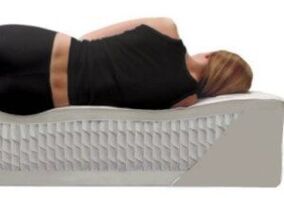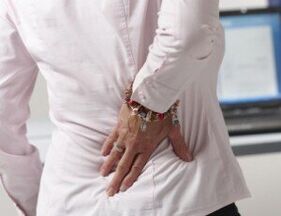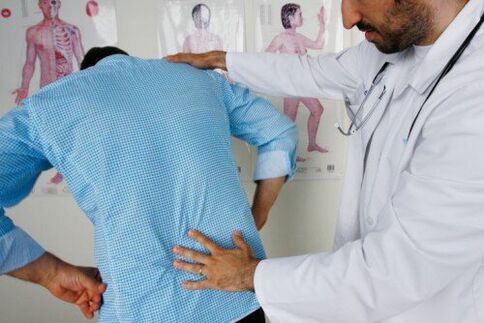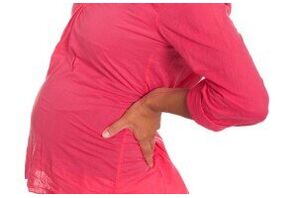Even children sometimes experience lower back pain. Adults know the trouble first hand. To cope with it, you need to find out: why the lower back hurts, what is the reason. The range of causes is wide: from benign to conditions requiring urgent medical attention. After finding the root of the disease, you will understand what to do, you can help yourself or by consulting a doctor.
Factors that trigger pain
Lumbar pain is a common phenomenon, but it belongs to the "accidental" category. It happens unexpectedly and always inappropriately. There is an explanation for everything, list the probable ones.
After sleeping
You wake up in the morning, you want to get up. . . And he can't. Sharp piercing back pain. The day before, I didn't lift weights, I didn't put any load on the muscles, it's not clear where the pain is coming from.
Operation algorithm:
- In the case of any pain, it is important to remain calm in order to properly assess the situation.Panic does not relieve the pain, but it can make it worse. It doesn't work, let's think about it lying down.
- Remember yesterday.If you spent your evenings in the office, watching TV or at the computer, and this is your usual routine, then the muscles (don't be surprised) experience overload. Continuously, daily. They don't have time to rest during the night. Passive rest does not help the recovery of tension-free muscles. Static loading is heavier than dynamic loading. The first (static) - in the same position - overloads some muscles, leaving others without work. Dynamics (movement) involve many muscles.
- We continue the analysis.You stress your muscles evenly, you do minimal exercises, you don't sit for eighteen hours a day, but you wake up with lower back pain.
Probable causes:
- Uncomfortable posture during sleep;
- A bed that is too hard or too soft;
- Manifestation of internal diseases.
The latter condition is rarely associated with sleep. A person feels bad after waking up, because in a dream the body relaxes and the feelings are dulled. The awakened person's perception sharpens, he moves - the suffering organ reacts.
- If you have calmed down, analyzed the situation, found out the cause of the pain - take action.When you are convinced: muscle pain that is not related to organ pathology, get up carefully. It doesn't work - roll to the edge of the bed, slide it to the floor. There you will exercise to relieve muscle spasm - this is the treatment.
Lower back pain after sleep, which appeared for the first time, usually occurs due to the reasons listed above.The deep, main reason is training and muscle weakness.Weakened muscles react to factors that strong ones "don't notice". It's not the hardness/softness of the bed, awkward movement and flabby muscles that cause pain.

Learn more about sleep comfort. Which bed is better: a controversial question with diametrically opposed answers. Proponents of hard beds insist on using a shield under the mattress, such a bed is called orthopedic. It is believed that a hard bed straightens the spine, which is good for posture.
Opponents of rigidity advocate a soft, thick mattress that allows the body to "sink" into the filler. In the semi-suspended state, the muscles and the spine occupy any position. The promoters of "soft sleep" argue that it is more useful, the approach is physiological. The mattress is also called orthopedic.
Lumbar pain occurs in both women and men after sleeping on any bed. Extremes are not the best solution. Our strong ancestors, our peasants, slept on chests or stoves, bedded with feather beds. A middle option. The posture was excellent, the pain after waking up was not typical for the young and middle-aged.
To keep the body in shape, the muscles - active, regular exercises help: exercises. Muscle training. How you can help yourself "right here and now" - that's what we're definitely talking about. If we look at all the possible causes and find out what could be why the lower back pain appeared.
You may also feel pain and a burning sensation in other cases, in the case of spinal diseases or injuries. Then non-specific mornings, disturbing regardless of the "sleepy" time.
After workout
Lack of load leads to weakness, muscle atrophy, overload - pain is rewarded for diligence. A reminder to the trainees: let's take the phrase "hurry up, slowly" as the motto of recovery. It is not always possible to row with strength and health hand in hand.Gradation is the key to success.
Calculating the optimal load is not difficult, you need two indicators:
- HR (heart rate, the number of heartbeats per minute is measured);
- Arterial pressure.
The heart rate is measured three times:
- Before class;
- At the end of the workout;
- 5 minutes past the hour.
In a relatively healthy person with an initial heart rate of 70-72, the heart rate can rise up to 120 (not more) with adequate load immediately after training. After 5 minutes, the heart rate should slow down: it should fall below 100 beats. If the pulse remains more frequent, the load is excessive, the muscles react with subsequent pain. The lower back is no exception.
Blood pressure should also return to normal within five minutes. This knowledge will tell you what you need to do in order to avoid pain in the lower back muscles after training.
Because of negative emotions
A person who is prone to emotions or who has been in a severe, prolonged stressful situation may experience pain of varying intensity in the lower back. They are not related to the organic change of the spine. The causes of back pain in the lumbar region lie in the body's response to stress.Nervous tension causes muscle spasms.Cramped muscles indicate dysfunction - pain.
This does not only happen in the lumbar region, muscle spasms can occur anywhere. Such a symptom is called psychosomatic pain in medicine.
Regular exercises aimed at strengthening and developing the muscles, forming the "muscle laces" - prevention of neurological pain.
Diseases of the spine
Diseases of the spine itself and dysfunction of the adjacent muscles are more difficult to treat. Main assistants: willpower, endurance, patience. Diseases have individual causes. The method of treatment depends on its nature.
Injuries
The muscles of the spine are damaged for two reasons:
- Causing harm to oneself out of ignorance: ignorance of one's own body's physiology, improper "exploitation" of the body.
- External influence (accidents, elements, unforeseen circumstances).
Self-mutilation is carried out unintentionally (exceptions are rare, we are talking about something else here), the injuries are caused by carelessness. The man didn't count his strength, he pulled up a heavy object and turned around awkwardly at the same time. Injury to the spine in the lumbar region. The pain is sharp, sharp, does not allow you to move.
This happens more often in men: they work more with weights.Usual recommendations from doctors:
- Restriction of movement (bed rest);
- Powerful injections for back and lower back pain;
- Warming rubbing, ointments, poultices, heating;
- Physiotherapy procedures;
- Massage;
- Exercise therapy - decrease in intensity, relief of symptoms and during remission.
Let's take a closer look at the essence of medical prescriptions:
- Rest (restriction of movements). The muscles are spasmodic, tense, some of them are blocked by the inappropriate load. By immobilizing the patient, the doctor involuntarily corrects this blockage: immobility does not relieve the spasm. Muscles become stiff - they lose their elasticity, they remain tense for a long time. Muscle tissue quickly weakens throughout the body deprived of movement. These are prerequisites for the transition of the disease to a chronic form.
- Pain relievers. Injections "suppress" the symptoms, it is easier for the patient. But there is no therapeutic effect. The cause remains, the person simply feels less pain for two or three hours. Strong drugs are also strong, causing side effects. Often the lumbosacral spinethe drug used to relieve his pain is a drug belonging to the group of phenylacetic acid derivatives causing serious problems in the gastrointestinal tract. Other pain relievers are not free from side effects. And they are used for a long time, courses.
- Pain is always swelling. Visible or hidden, pain and swelling coexist without fail. Edema is aggravated by heating manipulations. The situation is the same: the pain dulls, the problem persists or progresses.
- Physiotherapy for muscle spasms is close to placebo. The best scenario.
- A good massage is good, it relaxes the muscles. Careful stroking is useless, use a special massage that relieves spasms. It is painful at first, but it helps to heal quickly.
- Exercising immediately after an injury is essential. Through the pain, the correct movements restore the muscles to their normal state without medication. You need to know the exact diagnosis, focusing on this, choose a set of exercises. Leave the diagnosis to the doctor.
Serious injuries (soft tissue tears, fractures) require hospital treatment and sometimes surgery. But the most important thing in rehabilitation is the development, strengthening and restoration of the damaged muscles. Drug anesthesia is a temporary measure, recovery is achieved with regular exercises.
Osteochondrosis
Osteochondrosis can be called dystrophic changes of the intervertebral discs:
- The cartilaginous tissue of the discs wears out if the adjacent muscles that secure the spine are poorly developed and sluggish. The spine is vulnerable without the support of a reliable muscular ligament, and the load on the discs is uneven.
- The discs flatten, the tissues around them lose their elasticity, and they are spasmodic. The pain reflex is transmitted from the place of compression by the vertebrae of the intervertebral disc: from the spasmodic muscles through the nerve to the brain.
- The edges of the vertebrae are deformed, begin to grow, and the muscles are damaged.
- The chronic process develops gradually, the feeling of pain is distant from the beginning. It progresses from discomfort and dull pain - to growing, intense. It often leads to disability.
Osteochondrosis often occurs in men who are forced to lift weights. The disease often develops in women. Women tend to be more sedentarylack of exercise weakens the musculoskeletal system. Staying in one position for long periods of time overstretches some muscle groups without engaging others. There is pain in the spine in the lumbar and other segments.

The scheme is the same: muscle spasm, the signal from the pain receptors coming from the compressed discs is read by the nerve, the person feels debilitating pain. This is called "radicular syndrome" (doctors explain it as compression of the root of the spinal cord). Hypodynamia can be blamed in parallel with an irresponsible attitude to health. Muscle tissue can recover, and it needs your conscious help to do so. The pinched nerve (the second, inaccurate name of the syndrome, because the nerve does not contain pain receptors and transmits impulses from edematous muscles) is not easy to cure.Willpower, patience, and time are your allies.
The treatment is performed on an inpatient or outpatient basis, as well as for injuries that do not require surgery. Doctors use pain-relieving blockades, prescribe anti-inflammatory and pain-relieving injections.
Full muscle work can only be restored with regular exercise. A well-thought-out, competent practice system. Choose from a myriad of medical author rehabilitation methods - the one that's right for you.
Spondylosis
Untreated, progressive osteochondrosis can develop into spondylosis against the background of many violations of the treatment regimen and the body itself. The growth of bone tissue is an adaptive reaction of the body. The muscles of the skeleton and spine do not last. He tries to hold on with his own strength, pushing out supports - bone spikes. In advanced cases, the processes grow together with the adjacent vertebrae. The spine becomes fixed and rigid, the movement of the lower back is blocked.
The protrusions (outgrowths) at the edges of the spinal segments continuously damage the adjacent tissues.
Stop the disease in time, or better yet, prevent it.Do not allow the transition of osteochondrosis to spondylosis: the second is more difficult to treat.
At least half an hour - forty minutes of simple (don't forget gradual) exercises every day. Add regularity to gradation: don't skip classes. The result will be tangible within two to four weeks. The time of complete recovery depends on the initial state: how far the disease has progressed.
The right exercise definitely improves your well-being, but it only relieves the neglected part, not cures it. The disease is serious. Surgery for spondylosis is ineffective. Treatment is symptomatic. Anesthesia with ointments and injections.
The use of medicines is recommended when the pain in the lumbosacral region is unbearable. Dosage and frequency - set.Muscles strengthened by exercises eliminate the need for anesthesia.The pain will ease. Prevention guarantees that they will not return: exercise for muscles, joints and the whole body. At the same time, the body is completely healed.
Spondylarthrosis
Pain in the lumbosacral spine is expressed in spondylarthrosis. The pain may radiate to the buttocks and thighs.
The disease is characterized by damage to the joints located between the vertebral bodies. The cartilage of the joint is destroyed, the bone tissue is broken. Nearby muscles and ligaments are inflamed and tense. Mobility is reduced. The disease progresses, occurs in the elderly, young people rarely suffer - with congenital anomalies of the spine.
Factors provoking spondylarthrosis:
- Old age:
- Floor;
- Obesity;
- Hard physical work in the past;
- Power sports (weightlifting);
- Injuries;
- genetic predisposition.
In women, spondylarthrosis occurs twice as often. This fact is associated with metabolic disorders (fluctuations in the level and composition of hormones - pregnancy, menopause). It affects statistics and the difference in average life expectancy between different sexes. The age limit for spondylarthrosis is high, and women overcome it more often.
The method of treatment is decided by the doctor, we do not recommend surgeries. The procedures are aimed at reducing pain. The doctor prescribes medicines and doable exercises.
Radiculitis
If you do not cure osteochondrosis, it can be complicated by sciatica. The symptoms are similar, but the disease is more serious. Nerve fibers are affected - bundles located in the muscles near the spine along the spine. Painful, pulling, lower back pain radiating to the buttocks and left leg may indicate sciatica, osteochondrosis, or spinal hernia. The pain also radiates to the right leg, rarely bilateral. In the case of sciatica, it is difficult to find a position that relieves the intensity of the pain. If the pain radiates to the leg and there are other medical disorders of the spine, consult a doctor:good quality diagnosis is half of the success of the treatment.
In the absence of proper treatment, radiculitis leads to curvature of the spine. A common complication of the disease is vertebral hernia, the protrusion of the disc compressed by the vertebrae. With a hernia of the lumbar spine, the pain is constant, this is a serious consequence of sciatica.

The development of radiculitis has similar causes as osteochondrosis:
- Violation of posture;
- Muscle weakness;
- goose feet;
- The habit of improper "holding back" while walking, sitting, working and resting;
- Violation of metabolic processes.
If osteochondrosis develops, pain and burning sensation appear in the back, treat the problem immediately. Until it got worse.
Radiculitis is treated using the same method as osteochondrosis:
- Eliminating pain - application of ointments, gels, medicines;
- Reduces inflammation;
- Strengthen the muscular system with exercises.
tuberculous process
The infectious disease tuberculosis can cause myositis of any localization. If the muscles of the lumbar back are inflamed, they feel pain there. The tuberculous process in the bone tissue of the vertebrae is due to the fact that specific tuberculosis bacteria penetrate the vertebral tissue with the bloodstream. This provokes the development of tuberculosis spondylitis or osteomyelitis (bacteria infect the bone marrow of the spine).
Diseases with the etiology of lumbar tuberculosis are accompanied by severe pain in the advanced stage.
What to do if spinal tuberculosis is diagnosed? Follow the instructions of an experienced doctor. Delaying treatment is dangerous: the spine is gradually deformed: the vertebrae are destroyed, a hump is formed.
The treatment is long, antibacterial, and sometimes surgical. Limiting the load is recommended. Even after achieving remission, medical supervision is necessary.
Tumor
Tumor processes in the lumbar spine and adjacent tissues cause pain, which increases with the growth of the neoplasm. Any type of tumor causes discomfort: benign and malignant.
If a tumor is suspected, a thorough examination and treatment is vital.The symptoms may resemble a pinched nerve, sciatica, or a herniated disc. That's why it's important to see a doctor for a reliable diagnosis.
Diagnosis is difficult due to the similarity of symptoms with other diseases. Night and morning pains are typical. Tumors affecting the spinal cord are prognostically the most serious.
Benign tumors are treated and removed surgically. Malignant ones are more often formed by metastases from other organs and are difficult to cure. Contact an oncologist, he will plan and carry out the treatment. Treatment tactics: anesthesia, supportive therapy, if necessary, surgery.
Diseases of internal organs
disease, symptoms |
Why does the lower back hurt? |
Necessary measures |
|---|---|---|
A stroke is a violation of blood circulation in the brain. Failure of most body functions - speech, motor, mental. |
Acute circulatory failure due to rupture or narrowing of a blood vessel can affect the spinal cord. Its functioning is disturbed, hypoxia occurs. This causes pain. |
Call an ambulance immediately. |
Atypical acute appendicitis |
The pain occurs in places not typical for the disease - epigastrium, left side or lower back. |
Call an ambulance, hospitalization and surgery are possible. |
Pyelonephritis, ICD (kidney disease) |
The inflammatory process (pyelonephritis) or the progression of kidney stones causes pain of varying intensity in the lower back and lower abdomen - from painful to acute, unbearable. |
Call an ambulance. |
Ileus. Acute life-threatening condition: fecal and gas retention, vomiting, nausea, food masses do not move in the intestines. Cold sweat, fast pulse, drop in blood pressure. |
Pain in the form of contractions may occur in the lower back. |
Emergency hospitalization. |
Reflex pain |
Give them:
|
Medical examination, examination, diagnosis, and then assigning adequate treatment. |
women's issues
The causes of pain are not always pathologies when we are talking about women. Sometimes they lie purely in female physiology.
During pregnancy
Pain in the lower back of expectant mothers can be conditionally attributed to pain. This is a natural feeling of heaviness: the child is growing, the stomach is growing, the pelvic area bears the heaviest weight. This puts an increased load on the spine in the lumbar region. Imagine that a bag is attached to your belt, into which a bucket or a bucket and a half of water is poured. After several hours of walking with such a load, even a man will feel tired, his back will hurt. Carrying a child is not an easy pleasure in every sense.  In the early stages, the body rebuilds itself, it is felt.
In the early stages, the body rebuilds itself, it is felt.
A healthy woman does not perceive the desired "extra weight" as an unpleasant feeling.Normally developed muscles, exercise for pregnant women neutralizes the heavy feeling.If the pain is severe, the lower abdomen and lower back hurt, notify the doctor managing the pregnancy. The doctor will help you find out what it could be. Multiple pregnancies can increase the severity - the load is greater than usual. Aggravation of pre-pregnancy diseases is also not excluded, this will be revealed during a medical consultation.
Period
It shows a normal process: the woman is healthy. At the beginning of menstruation, the cervix opens a little, pulling pain may occur. Then the inner mucous membrane lining the uterus is expelled - pain may also occur. If the pain is unbearable - consult a doctor, he will tell you how to normalize menstruation. An irregular cycle may indicate hormonal disorders.
How to relieve pain
Acute muscular back pain that is not associated with organ damage can be alleviated on its own, quickly and without medication.
Intensive exhalation (deep, from the abdomen) activates the function of the diaphragm, activates blood circulation, and the condition is alleviated.
- Lying on your back, put a cold object under the lower back (a heating pad with ice, a bag of frozen vegetables, etc. ), the cold also numbs the edematous muscles.
- Bend the legs slightly at the knees.
- We put our hands to the ears, raise the head and shoulders when exhaling, and lower them when inhaling.
The cold relieves swelling and activates blood flow in the lower back. The pain recedes.
Get down on all fours on the floor, stretch your muscles by walking with support on your palms and knees. 5-20 minutes is the optimal duration of the exercise. Edema disappears, anesthesia occurs.
Lie on your back with your feet on a bench (sofa, other comfortable support). Under the lower back - a heating pad with ice. Hands behind head. When exhaling, raise the shoulder, try to reach the knee with the elbow. Do 20 reps or more if possible. Muscles develop, swelling and spasms disappear, pain goes away.
There is an exercise complex that strengthens the muscles of the lower back, here are the main ones that will quickly relieve pain. It's like an ambulance. The exercises are safe, initial pain is natural. If you start performing these movements as soon as a person feels discomfort, "pulled" the muscles, the pain syndrome can be alleviated in one or two sessions.
Medicinal pain relievers provide temporary relief, but do not eliminate the problem.If it is unbearable, apply ointment, folk remedies (salt water, herbal baths), but the emphasis is on exercises.
Alternate between work and rest sensibly, allow yourself a good night's sleep.
Don't be a jerk: move your muscles proactively. Practice movements that eliminate muscle stiffness. They are a dynamic body. Don't force it by using reasonable exercises. With patience. The work of the muscles is controlled by the mind, their regenerating (regenerating) ability is amazing. Under load, new pathways are innervated, bypassing the damaged ones, and temporarily lost functions of the muscles affected by the disease or external influence are restored.
Anatomical changes affect only the roads. Health, well-being, mobility - it will be restored.
There is no better investment than investing in your own health. It's about investing effort: exercise is part of the lifestyle. Make it a habit - every day, like brushing your teeth.
Nursing the disease is not an option. The desire to find a comfortable position that relieves pain is understandable. But if "movement is life", then peace (which is longed for in case of pain) is the opposite of life. Few people are interested in eternal rest - with any degree of laziness - that is why ailing muscles must be disturbed. Through pain Diseases are loved whenthey are pampered (bed rest, minimal movement, warming up and other pampering) Butdiseases recede before the brave, crossing the fear of experiencing pain and through it himself. Overcome self-pity: it's an excuse for laziness and fear. A little courage, regular light work, and you will forget about lower back pain.

















































